Financial and Economic Literacy Report: Concepts and Theories
VerifiedAdded on 2020/07/22
|16
|3773
|33
Report
AI Summary
This report provides a comprehensive analysis of financial and economic literacy, focusing on key concepts and their application in business decision-making. It begins with an examination of market structures, including SMEs and MNCs, and explores related economic theories. The report then delves into business economic concepts, such as demand, supply, and monetary policy, with specific reference to the UK housing market and the role of the Bank of England. Macroeconomic indicators and their impact on the UK economy are discussed, along with the application of leverage and current account management. Furthermore, the report includes an interpretation of financial ratios, present value calculations, and capital investment techniques, providing a practical guide for managers. The analysis incorporates relevant economic theories and real-world examples, such as the case of The Conron shop in Marylebone and financial data from Morrisons Plc, to illustrate the concepts discussed. The report aims to equip managers with the knowledge and tools necessary for informed financial and economic decision-making.
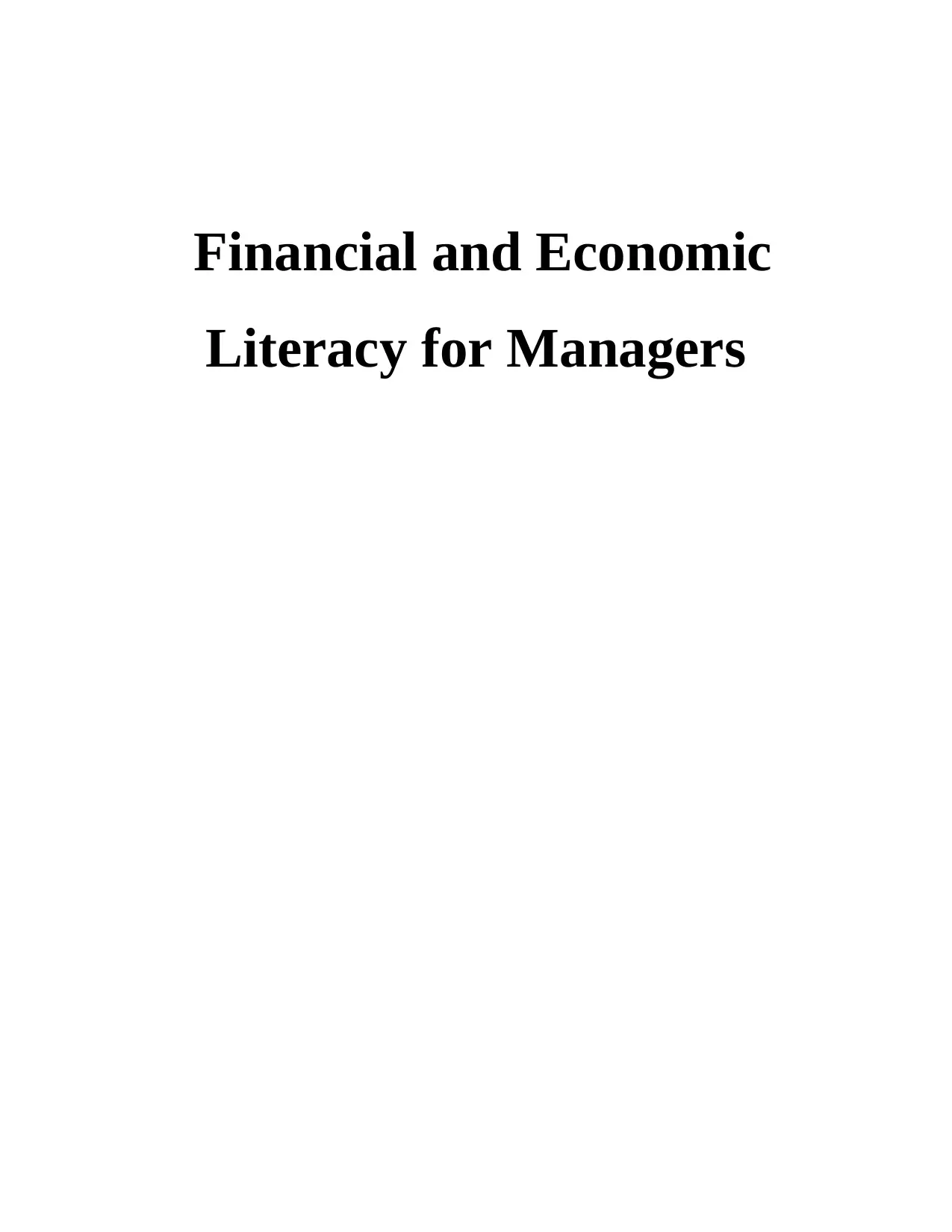
Financial and Economic
Literacy for Managers
Literacy for Managers
Paraphrase This Document
Need a fresh take? Get an instant paraphrase of this document with our AI Paraphraser
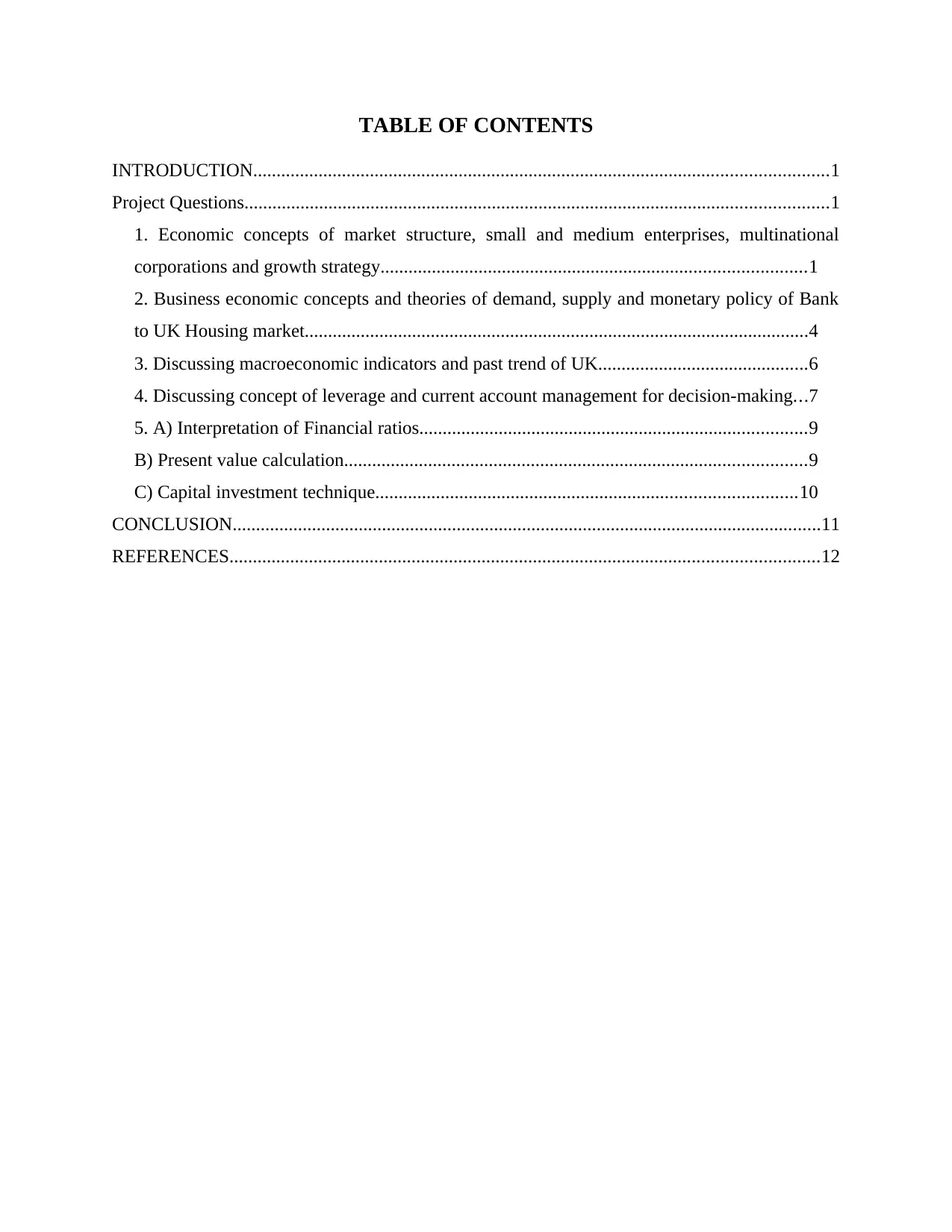
TABLE OF CONTENTS
INTRODUCTION...........................................................................................................................1
Project Questions.............................................................................................................................1
1. Economic concepts of market structure, small and medium enterprises, multinational
corporations and growth strategy...........................................................................................1
2. Business economic concepts and theories of demand, supply and monetary policy of Bank
to UK Housing market............................................................................................................4
3. Discussing macroeconomic indicators and past trend of UK.............................................6
4. Discussing concept of leverage and current account management for decision-making...7
5. A) Interpretation of Financial ratios...................................................................................9
B) Present value calculation...................................................................................................9
C) Capital investment technique..........................................................................................10
CONCLUSION..............................................................................................................................11
REFERENCES..............................................................................................................................12
INTRODUCTION...........................................................................................................................1
Project Questions.............................................................................................................................1
1. Economic concepts of market structure, small and medium enterprises, multinational
corporations and growth strategy...........................................................................................1
2. Business economic concepts and theories of demand, supply and monetary policy of Bank
to UK Housing market............................................................................................................4
3. Discussing macroeconomic indicators and past trend of UK.............................................6
4. Discussing concept of leverage and current account management for decision-making...7
5. A) Interpretation of Financial ratios...................................................................................9
B) Present value calculation...................................................................................................9
C) Capital investment technique..........................................................................................10
CONCLUSION..............................................................................................................................11
REFERENCES..............................................................................................................................12
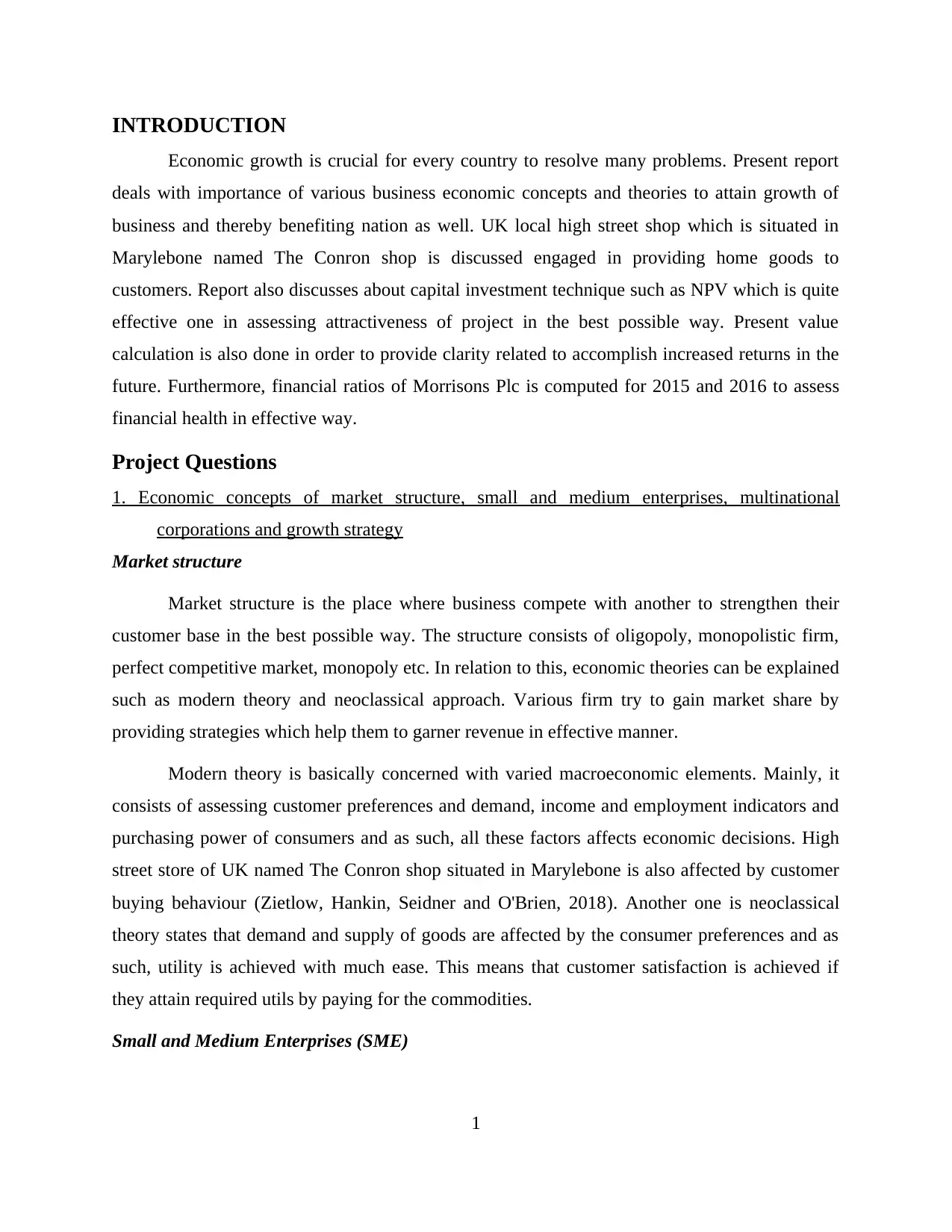
INTRODUCTION
Economic growth is crucial for every country to resolve many problems. Present report
deals with importance of various business economic concepts and theories to attain growth of
business and thereby benefiting nation as well. UK local high street shop which is situated in
Marylebone named The Conron shop is discussed engaged in providing home goods to
customers. Report also discusses about capital investment technique such as NPV which is quite
effective one in assessing attractiveness of project in the best possible way. Present value
calculation is also done in order to provide clarity related to accomplish increased returns in the
future. Furthermore, financial ratios of Morrisons Plc is computed for 2015 and 2016 to assess
financial health in effective way.
Project Questions
1. Economic concepts of market structure, small and medium enterprises, multinational
corporations and growth strategy
Market structure
Market structure is the place where business compete with another to strengthen their
customer base in the best possible way. The structure consists of oligopoly, monopolistic firm,
perfect competitive market, monopoly etc. In relation to this, economic theories can be explained
such as modern theory and neoclassical approach. Various firm try to gain market share by
providing strategies which help them to garner revenue in effective manner.
Modern theory is basically concerned with varied macroeconomic elements. Mainly, it
consists of assessing customer preferences and demand, income and employment indicators and
purchasing power of consumers and as such, all these factors affects economic decisions. High
street store of UK named The Conron shop situated in Marylebone is also affected by customer
buying behaviour (Zietlow, Hankin, Seidner and O'Brien, 2018). Another one is neoclassical
theory states that demand and supply of goods are affected by the consumer preferences and as
such, utility is achieved with much ease. This means that customer satisfaction is achieved if
they attain required utils by paying for the commodities.
Small and Medium Enterprises (SME)
1
Economic growth is crucial for every country to resolve many problems. Present report
deals with importance of various business economic concepts and theories to attain growth of
business and thereby benefiting nation as well. UK local high street shop which is situated in
Marylebone named The Conron shop is discussed engaged in providing home goods to
customers. Report also discusses about capital investment technique such as NPV which is quite
effective one in assessing attractiveness of project in the best possible way. Present value
calculation is also done in order to provide clarity related to accomplish increased returns in the
future. Furthermore, financial ratios of Morrisons Plc is computed for 2015 and 2016 to assess
financial health in effective way.
Project Questions
1. Economic concepts of market structure, small and medium enterprises, multinational
corporations and growth strategy
Market structure
Market structure is the place where business compete with another to strengthen their
customer base in the best possible way. The structure consists of oligopoly, monopolistic firm,
perfect competitive market, monopoly etc. In relation to this, economic theories can be explained
such as modern theory and neoclassical approach. Various firm try to gain market share by
providing strategies which help them to garner revenue in effective manner.
Modern theory is basically concerned with varied macroeconomic elements. Mainly, it
consists of assessing customer preferences and demand, income and employment indicators and
purchasing power of consumers and as such, all these factors affects economic decisions. High
street store of UK named The Conron shop situated in Marylebone is also affected by customer
buying behaviour (Zietlow, Hankin, Seidner and O'Brien, 2018). Another one is neoclassical
theory states that demand and supply of goods are affected by the consumer preferences and as
such, utility is achieved with much ease. This means that customer satisfaction is achieved if
they attain required utils by paying for the commodities.
Small and Medium Enterprises (SME)
1
⊘ This is a preview!⊘
Do you want full access?
Subscribe today to unlock all pages.

Trusted by 1+ million students worldwide
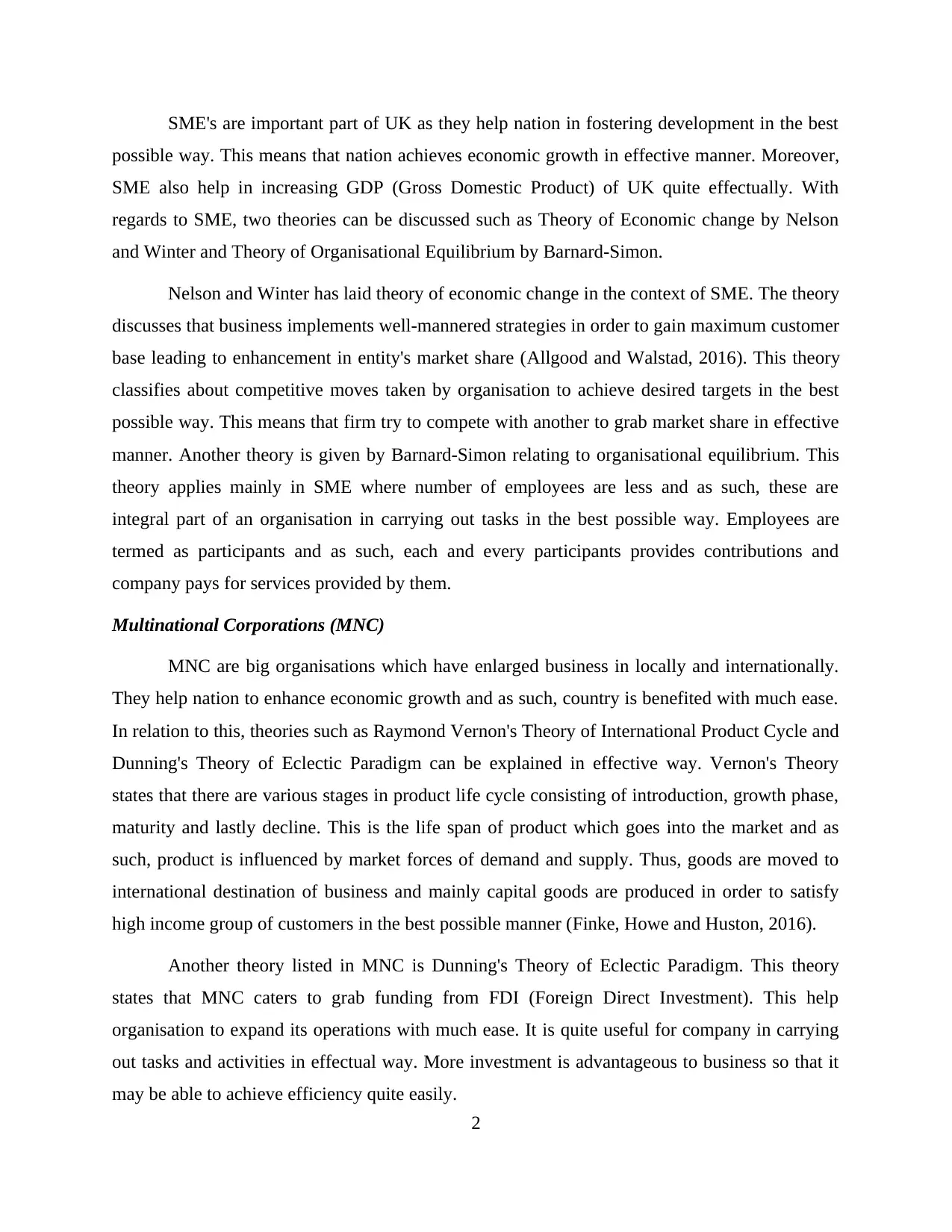
SME's are important part of UK as they help nation in fostering development in the best
possible way. This means that nation achieves economic growth in effective manner. Moreover,
SME also help in increasing GDP (Gross Domestic Product) of UK quite effectually. With
regards to SME, two theories can be discussed such as Theory of Economic change by Nelson
and Winter and Theory of Organisational Equilibrium by Barnard-Simon.
Nelson and Winter has laid theory of economic change in the context of SME. The theory
discusses that business implements well-mannered strategies in order to gain maximum customer
base leading to enhancement in entity's market share (Allgood and Walstad, 2016). This theory
classifies about competitive moves taken by organisation to achieve desired targets in the best
possible way. This means that firm try to compete with another to grab market share in effective
manner. Another theory is given by Barnard-Simon relating to organisational equilibrium. This
theory applies mainly in SME where number of employees are less and as such, these are
integral part of an organisation in carrying out tasks in the best possible way. Employees are
termed as participants and as such, each and every participants provides contributions and
company pays for services provided by them.
Multinational Corporations (MNC)
MNC are big organisations which have enlarged business in locally and internationally.
They help nation to enhance economic growth and as such, country is benefited with much ease.
In relation to this, theories such as Raymond Vernon's Theory of International Product Cycle and
Dunning's Theory of Eclectic Paradigm can be explained in effective way. Vernon's Theory
states that there are various stages in product life cycle consisting of introduction, growth phase,
maturity and lastly decline. This is the life span of product which goes into the market and as
such, product is influenced by market forces of demand and supply. Thus, goods are moved to
international destination of business and mainly capital goods are produced in order to satisfy
high income group of customers in the best possible manner (Finke, Howe and Huston, 2016).
Another theory listed in MNC is Dunning's Theory of Eclectic Paradigm. This theory
states that MNC caters to grab funding from FDI (Foreign Direct Investment). This help
organisation to expand its operations with much ease. It is quite useful for company in carrying
out tasks and activities in effectual way. More investment is advantageous to business so that it
may be able to achieve efficiency quite easily.
2
possible way. This means that nation achieves economic growth in effective manner. Moreover,
SME also help in increasing GDP (Gross Domestic Product) of UK quite effectually. With
regards to SME, two theories can be discussed such as Theory of Economic change by Nelson
and Winter and Theory of Organisational Equilibrium by Barnard-Simon.
Nelson and Winter has laid theory of economic change in the context of SME. The theory
discusses that business implements well-mannered strategies in order to gain maximum customer
base leading to enhancement in entity's market share (Allgood and Walstad, 2016). This theory
classifies about competitive moves taken by organisation to achieve desired targets in the best
possible way. This means that firm try to compete with another to grab market share in effective
manner. Another theory is given by Barnard-Simon relating to organisational equilibrium. This
theory applies mainly in SME where number of employees are less and as such, these are
integral part of an organisation in carrying out tasks in the best possible way. Employees are
termed as participants and as such, each and every participants provides contributions and
company pays for services provided by them.
Multinational Corporations (MNC)
MNC are big organisations which have enlarged business in locally and internationally.
They help nation to enhance economic growth and as such, country is benefited with much ease.
In relation to this, theories such as Raymond Vernon's Theory of International Product Cycle and
Dunning's Theory of Eclectic Paradigm can be explained in effective way. Vernon's Theory
states that there are various stages in product life cycle consisting of introduction, growth phase,
maturity and lastly decline. This is the life span of product which goes into the market and as
such, product is influenced by market forces of demand and supply. Thus, goods are moved to
international destination of business and mainly capital goods are produced in order to satisfy
high income group of customers in the best possible manner (Finke, Howe and Huston, 2016).
Another theory listed in MNC is Dunning's Theory of Eclectic Paradigm. This theory
states that MNC caters to grab funding from FDI (Foreign Direct Investment). This help
organisation to expand its operations with much ease. It is quite useful for company in carrying
out tasks and activities in effectual way. More investment is advantageous to business so that it
may be able to achieve efficiency quite easily.
2
Paraphrase This Document
Need a fresh take? Get an instant paraphrase of this document with our AI Paraphraser
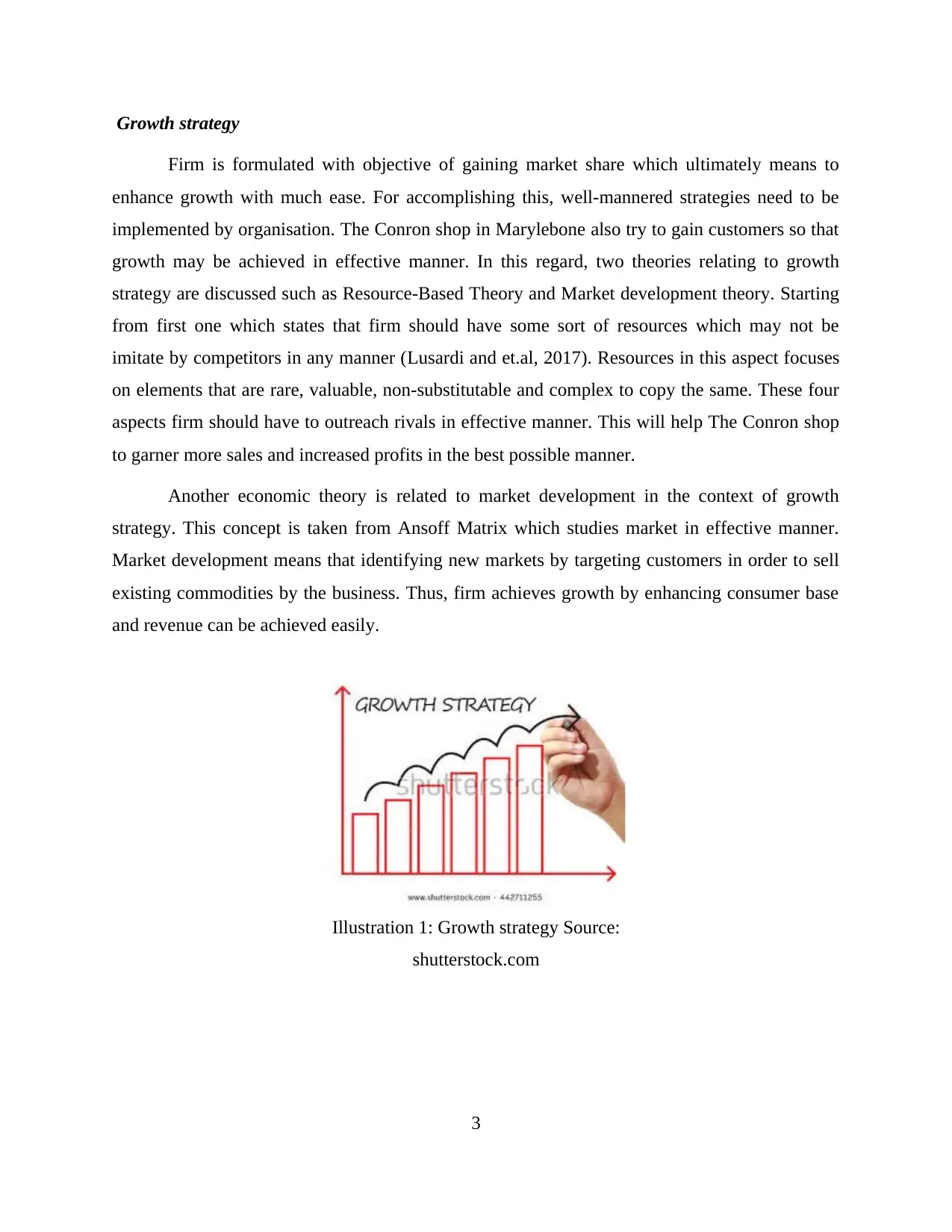
Growth strategy
Firm is formulated with objective of gaining market share which ultimately means to
enhance growth with much ease. For accomplishing this, well-mannered strategies need to be
implemented by organisation. The Conron shop in Marylebone also try to gain customers so that
growth may be achieved in effective manner. In this regard, two theories relating to growth
strategy are discussed such as Resource-Based Theory and Market development theory. Starting
from first one which states that firm should have some sort of resources which may not be
imitate by competitors in any manner (Lusardi and et.al, 2017). Resources in this aspect focuses
on elements that are rare, valuable, non-substitutable and complex to copy the same. These four
aspects firm should have to outreach rivals in effective manner. This will help The Conron shop
to garner more sales and increased profits in the best possible manner.
Another economic theory is related to market development in the context of growth
strategy. This concept is taken from Ansoff Matrix which studies market in effective manner.
Market development means that identifying new markets by targeting customers in order to sell
existing commodities by the business. Thus, firm achieves growth by enhancing consumer base
and revenue can be achieved easily.
3
Illustration 1: Growth strategy Source:
shutterstock.com
Firm is formulated with objective of gaining market share which ultimately means to
enhance growth with much ease. For accomplishing this, well-mannered strategies need to be
implemented by organisation. The Conron shop in Marylebone also try to gain customers so that
growth may be achieved in effective manner. In this regard, two theories relating to growth
strategy are discussed such as Resource-Based Theory and Market development theory. Starting
from first one which states that firm should have some sort of resources which may not be
imitate by competitors in any manner (Lusardi and et.al, 2017). Resources in this aspect focuses
on elements that are rare, valuable, non-substitutable and complex to copy the same. These four
aspects firm should have to outreach rivals in effective manner. This will help The Conron shop
to garner more sales and increased profits in the best possible manner.
Another economic theory is related to market development in the context of growth
strategy. This concept is taken from Ansoff Matrix which studies market in effective manner.
Market development means that identifying new markets by targeting customers in order to sell
existing commodities by the business. Thus, firm achieves growth by enhancing consumer base
and revenue can be achieved easily.
3
Illustration 1: Growth strategy Source:
shutterstock.com
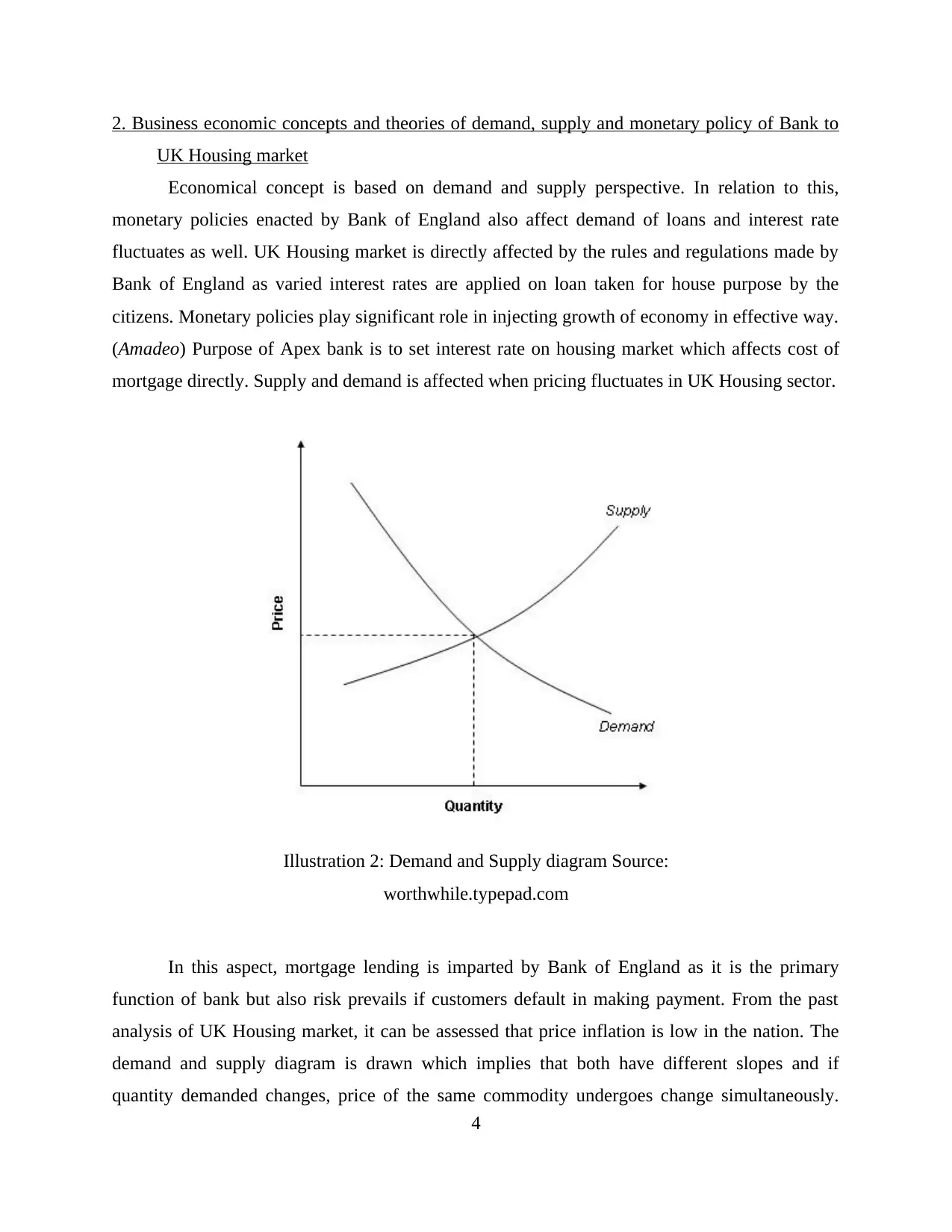
2. Business economic concepts and theories of demand, supply and monetary policy of Bank to
UK Housing market
Economical concept is based on demand and supply perspective. In relation to this,
monetary policies enacted by Bank of England also affect demand of loans and interest rate
fluctuates as well. UK Housing market is directly affected by the rules and regulations made by
Bank of England as varied interest rates are applied on loan taken for house purpose by the
citizens. Monetary policies play significant role in injecting growth of economy in effective way.
(Amadeo) Purpose of Apex bank is to set interest rate on housing market which affects cost of
mortgage directly. Supply and demand is affected when pricing fluctuates in UK Housing sector.
In this aspect, mortgage lending is imparted by Bank of England as it is the primary
function of bank but also risk prevails if customers default in making payment. From the past
analysis of UK Housing market, it can be assessed that price inflation is low in the nation. The
demand and supply diagram is drawn which implies that both have different slopes and if
quantity demanded changes, price of the same commodity undergoes change simultaneously.
4
Illustration 2: Demand and Supply diagram Source:
worthwhile.typepad.com
UK Housing market
Economical concept is based on demand and supply perspective. In relation to this,
monetary policies enacted by Bank of England also affect demand of loans and interest rate
fluctuates as well. UK Housing market is directly affected by the rules and regulations made by
Bank of England as varied interest rates are applied on loan taken for house purpose by the
citizens. Monetary policies play significant role in injecting growth of economy in effective way.
(Amadeo) Purpose of Apex bank is to set interest rate on housing market which affects cost of
mortgage directly. Supply and demand is affected when pricing fluctuates in UK Housing sector.
In this aspect, mortgage lending is imparted by Bank of England as it is the primary
function of bank but also risk prevails if customers default in making payment. From the past
analysis of UK Housing market, it can be assessed that price inflation is low in the nation. The
demand and supply diagram is drawn which implies that both have different slopes and if
quantity demanded changes, price of the same commodity undergoes change simultaneously.
4
Illustration 2: Demand and Supply diagram Source:
worthwhile.typepad.com
⊘ This is a preview!⊘
Do you want full access?
Subscribe today to unlock all pages.

Trusted by 1+ million students worldwide
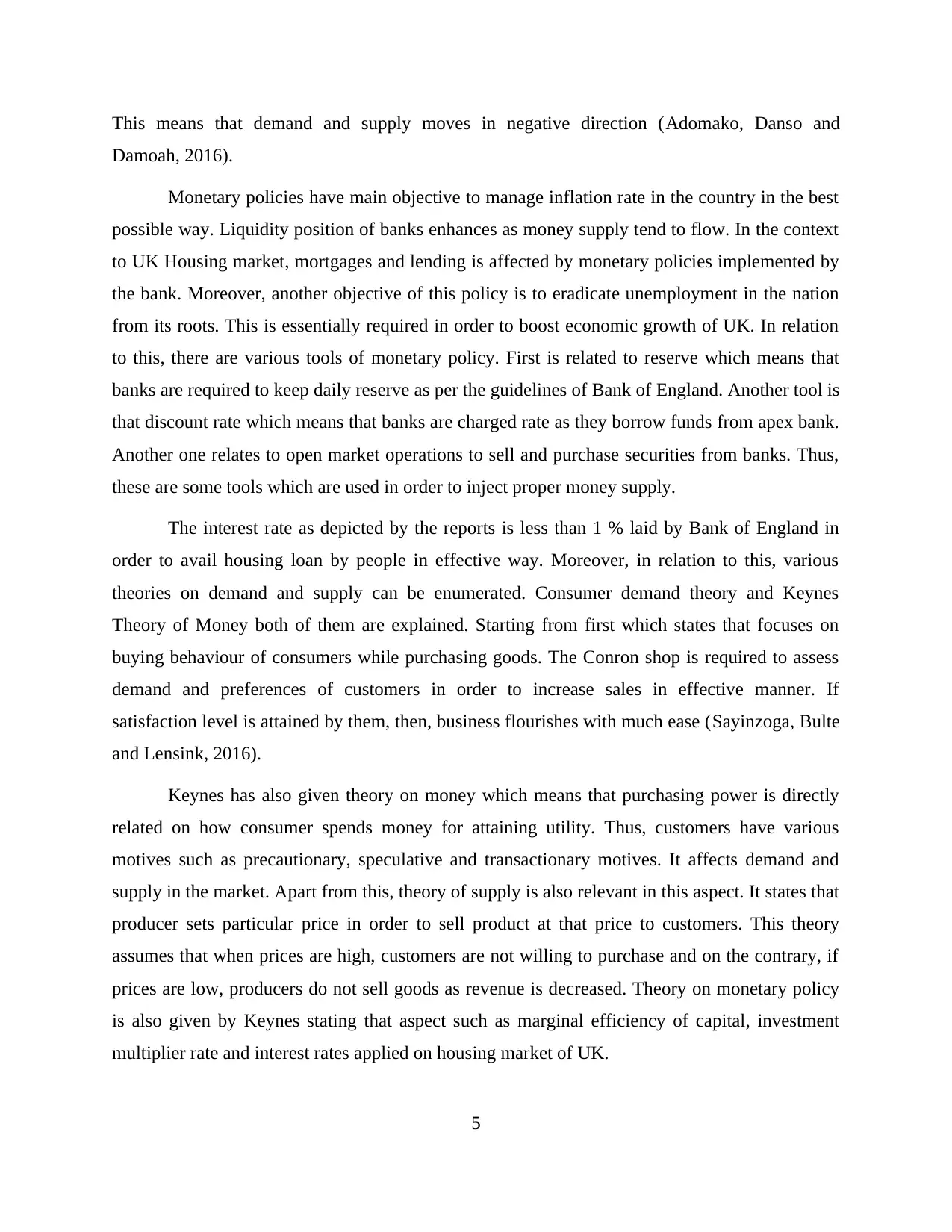
This means that demand and supply moves in negative direction (Adomako, Danso and
Damoah, 2016).
Monetary policies have main objective to manage inflation rate in the country in the best
possible way. Liquidity position of banks enhances as money supply tend to flow. In the context
to UK Housing market, mortgages and lending is affected by monetary policies implemented by
the bank. Moreover, another objective of this policy is to eradicate unemployment in the nation
from its roots. This is essentially required in order to boost economic growth of UK. In relation
to this, there are various tools of monetary policy. First is related to reserve which means that
banks are required to keep daily reserve as per the guidelines of Bank of England. Another tool is
that discount rate which means that banks are charged rate as they borrow funds from apex bank.
Another one relates to open market operations to sell and purchase securities from banks. Thus,
these are some tools which are used in order to inject proper money supply.
The interest rate as depicted by the reports is less than 1 % laid by Bank of England in
order to avail housing loan by people in effective way. Moreover, in relation to this, various
theories on demand and supply can be enumerated. Consumer demand theory and Keynes
Theory of Money both of them are explained. Starting from first which states that focuses on
buying behaviour of consumers while purchasing goods. The Conron shop is required to assess
demand and preferences of customers in order to increase sales in effective manner. If
satisfaction level is attained by them, then, business flourishes with much ease (Sayinzoga, Bulte
and Lensink, 2016).
Keynes has also given theory on money which means that purchasing power is directly
related on how consumer spends money for attaining utility. Thus, customers have various
motives such as precautionary, speculative and transactionary motives. It affects demand and
supply in the market. Apart from this, theory of supply is also relevant in this aspect. It states that
producer sets particular price in order to sell product at that price to customers. This theory
assumes that when prices are high, customers are not willing to purchase and on the contrary, if
prices are low, producers do not sell goods as revenue is decreased. Theory on monetary policy
is also given by Keynes stating that aspect such as marginal efficiency of capital, investment
multiplier rate and interest rates applied on housing market of UK.
5
Damoah, 2016).
Monetary policies have main objective to manage inflation rate in the country in the best
possible way. Liquidity position of banks enhances as money supply tend to flow. In the context
to UK Housing market, mortgages and lending is affected by monetary policies implemented by
the bank. Moreover, another objective of this policy is to eradicate unemployment in the nation
from its roots. This is essentially required in order to boost economic growth of UK. In relation
to this, there are various tools of monetary policy. First is related to reserve which means that
banks are required to keep daily reserve as per the guidelines of Bank of England. Another tool is
that discount rate which means that banks are charged rate as they borrow funds from apex bank.
Another one relates to open market operations to sell and purchase securities from banks. Thus,
these are some tools which are used in order to inject proper money supply.
The interest rate as depicted by the reports is less than 1 % laid by Bank of England in
order to avail housing loan by people in effective way. Moreover, in relation to this, various
theories on demand and supply can be enumerated. Consumer demand theory and Keynes
Theory of Money both of them are explained. Starting from first which states that focuses on
buying behaviour of consumers while purchasing goods. The Conron shop is required to assess
demand and preferences of customers in order to increase sales in effective manner. If
satisfaction level is attained by them, then, business flourishes with much ease (Sayinzoga, Bulte
and Lensink, 2016).
Keynes has also given theory on money which means that purchasing power is directly
related on how consumer spends money for attaining utility. Thus, customers have various
motives such as precautionary, speculative and transactionary motives. It affects demand and
supply in the market. Apart from this, theory of supply is also relevant in this aspect. It states that
producer sets particular price in order to sell product at that price to customers. This theory
assumes that when prices are high, customers are not willing to purchase and on the contrary, if
prices are low, producers do not sell goods as revenue is decreased. Theory on monetary policy
is also given by Keynes stating that aspect such as marginal efficiency of capital, investment
multiplier rate and interest rates applied on housing market of UK.
5
Paraphrase This Document
Need a fresh take? Get an instant paraphrase of this document with our AI Paraphraser
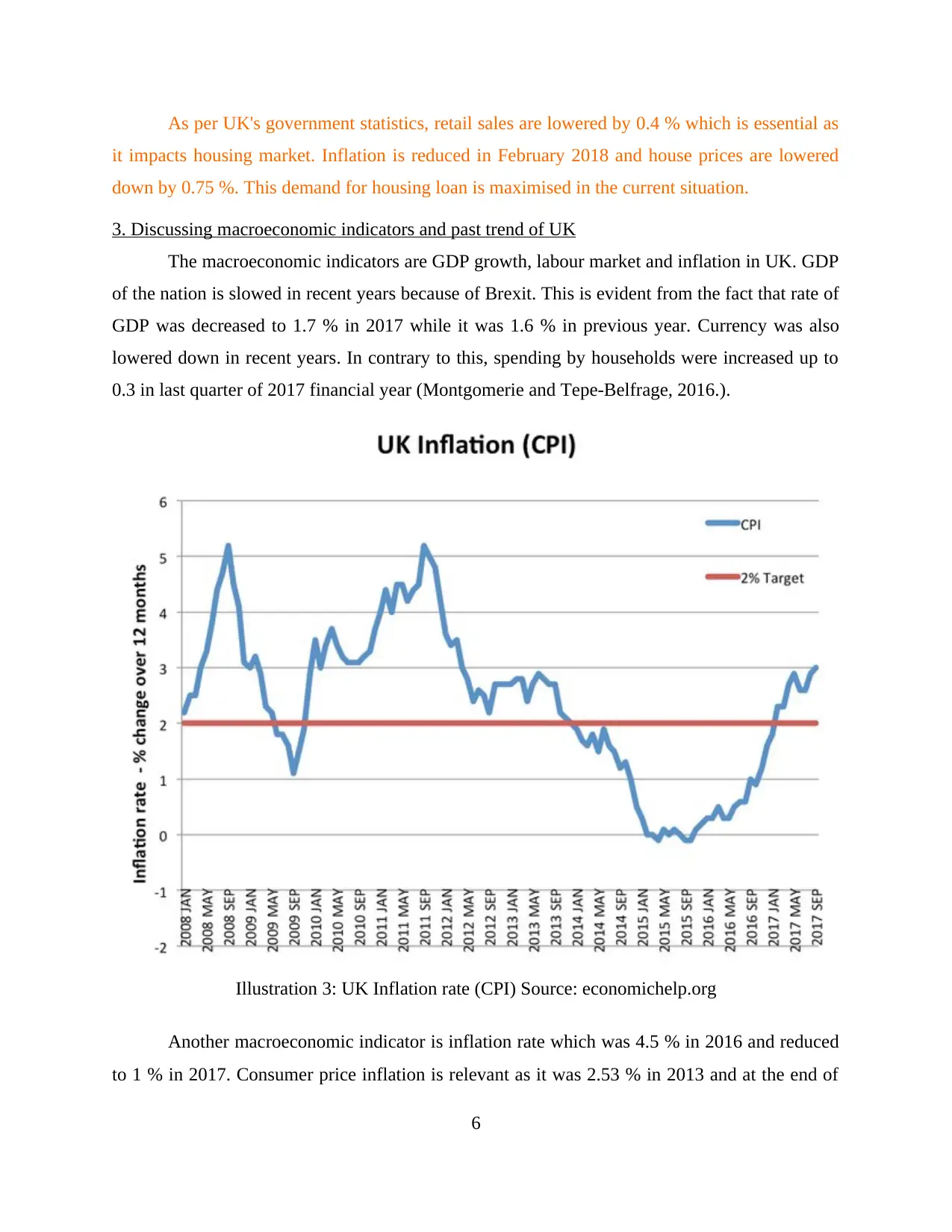
As per UK's government statistics, retail sales are lowered by 0.4 % which is essential as
it impacts housing market. Inflation is reduced in February 2018 and house prices are lowered
down by 0.75 %. This demand for housing loan is maximised in the current situation.
3. Discussing macroeconomic indicators and past trend of UK
The macroeconomic indicators are GDP growth, labour market and inflation in UK. GDP
of the nation is slowed in recent years because of Brexit. This is evident from the fact that rate of
GDP was decreased to 1.7 % in 2017 while it was 1.6 % in previous year. Currency was also
lowered down in recent years. In contrary to this, spending by households were increased up to
0.3 in last quarter of 2017 financial year (Montgomerie and Tepe-Belfrage, 2016.).
Another macroeconomic indicator is inflation rate which was 4.5 % in 2016 and reduced
to 1 % in 2017. Consumer price inflation is relevant as it was 2.53 % in 2013 and at the end of
6
Illustration 3: UK Inflation rate (CPI) Source: economichelp.org
it impacts housing market. Inflation is reduced in February 2018 and house prices are lowered
down by 0.75 %. This demand for housing loan is maximised in the current situation.
3. Discussing macroeconomic indicators and past trend of UK
The macroeconomic indicators are GDP growth, labour market and inflation in UK. GDP
of the nation is slowed in recent years because of Brexit. This is evident from the fact that rate of
GDP was decreased to 1.7 % in 2017 while it was 1.6 % in previous year. Currency was also
lowered down in recent years. In contrary to this, spending by households were increased up to
0.3 in last quarter of 2017 financial year (Montgomerie and Tepe-Belfrage, 2016.).
Another macroeconomic indicator is inflation rate which was 4.5 % in 2016 and reduced
to 1 % in 2017. Consumer price inflation is relevant as it was 2.53 % in 2013 and at the end of
6
Illustration 3: UK Inflation rate (CPI) Source: economichelp.org
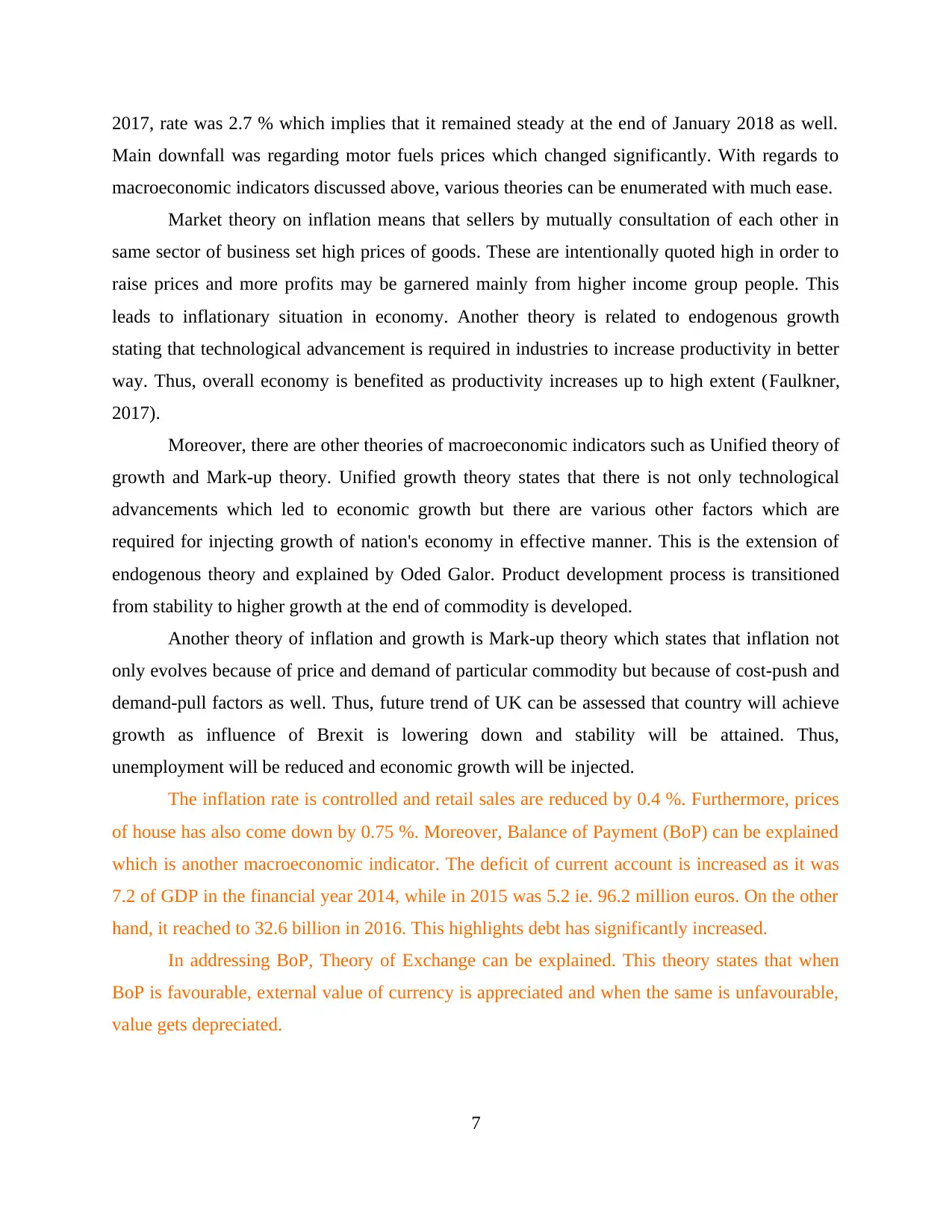
2017, rate was 2.7 % which implies that it remained steady at the end of January 2018 as well.
Main downfall was regarding motor fuels prices which changed significantly. With regards to
macroeconomic indicators discussed above, various theories can be enumerated with much ease.
Market theory on inflation means that sellers by mutually consultation of each other in
same sector of business set high prices of goods. These are intentionally quoted high in order to
raise prices and more profits may be garnered mainly from higher income group people. This
leads to inflationary situation in economy. Another theory is related to endogenous growth
stating that technological advancement is required in industries to increase productivity in better
way. Thus, overall economy is benefited as productivity increases up to high extent (Faulkner,
2017).
Moreover, there are other theories of macroeconomic indicators such as Unified theory of
growth and Mark-up theory. Unified growth theory states that there is not only technological
advancements which led to economic growth but there are various other factors which are
required for injecting growth of nation's economy in effective manner. This is the extension of
endogenous theory and explained by Oded Galor. Product development process is transitioned
from stability to higher growth at the end of commodity is developed.
Another theory of inflation and growth is Mark-up theory which states that inflation not
only evolves because of price and demand of particular commodity but because of cost-push and
demand-pull factors as well. Thus, future trend of UK can be assessed that country will achieve
growth as influence of Brexit is lowering down and stability will be attained. Thus,
unemployment will be reduced and economic growth will be injected.
The inflation rate is controlled and retail sales are reduced by 0.4 %. Furthermore, prices
of house has also come down by 0.75 %. Moreover, Balance of Payment (BoP) can be explained
which is another macroeconomic indicator. The deficit of current account is increased as it was
7.2 of GDP in the financial year 2014, while in 2015 was 5.2 ie. 96.2 million euros. On the other
hand, it reached to 32.6 billion in 2016. This highlights debt has significantly increased.
In addressing BoP, Theory of Exchange can be explained. This theory states that when
BoP is favourable, external value of currency is appreciated and when the same is unfavourable,
value gets depreciated.
7
Main downfall was regarding motor fuels prices which changed significantly. With regards to
macroeconomic indicators discussed above, various theories can be enumerated with much ease.
Market theory on inflation means that sellers by mutually consultation of each other in
same sector of business set high prices of goods. These are intentionally quoted high in order to
raise prices and more profits may be garnered mainly from higher income group people. This
leads to inflationary situation in economy. Another theory is related to endogenous growth
stating that technological advancement is required in industries to increase productivity in better
way. Thus, overall economy is benefited as productivity increases up to high extent (Faulkner,
2017).
Moreover, there are other theories of macroeconomic indicators such as Unified theory of
growth and Mark-up theory. Unified growth theory states that there is not only technological
advancements which led to economic growth but there are various other factors which are
required for injecting growth of nation's economy in effective manner. This is the extension of
endogenous theory and explained by Oded Galor. Product development process is transitioned
from stability to higher growth at the end of commodity is developed.
Another theory of inflation and growth is Mark-up theory which states that inflation not
only evolves because of price and demand of particular commodity but because of cost-push and
demand-pull factors as well. Thus, future trend of UK can be assessed that country will achieve
growth as influence of Brexit is lowering down and stability will be attained. Thus,
unemployment will be reduced and economic growth will be injected.
The inflation rate is controlled and retail sales are reduced by 0.4 %. Furthermore, prices
of house has also come down by 0.75 %. Moreover, Balance of Payment (BoP) can be explained
which is another macroeconomic indicator. The deficit of current account is increased as it was
7.2 of GDP in the financial year 2014, while in 2015 was 5.2 ie. 96.2 million euros. On the other
hand, it reached to 32.6 billion in 2016. This highlights debt has significantly increased.
In addressing BoP, Theory of Exchange can be explained. This theory states that when
BoP is favourable, external value of currency is appreciated and when the same is unfavourable,
value gets depreciated.
7
⊘ This is a preview!⊘
Do you want full access?
Subscribe today to unlock all pages.

Trusted by 1+ million students worldwide
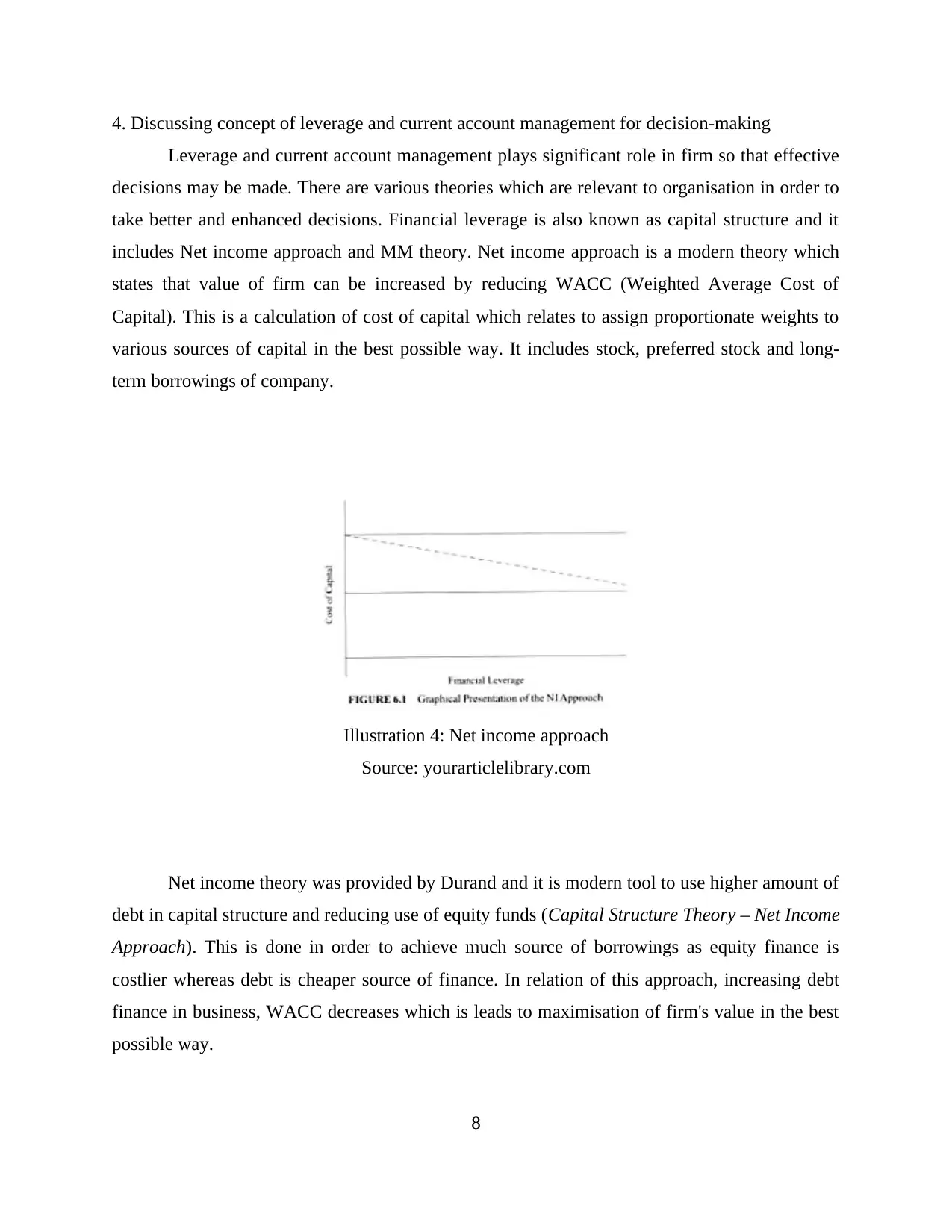
4. Discussing concept of leverage and current account management for decision-making
Leverage and current account management plays significant role in firm so that effective
decisions may be made. There are various theories which are relevant to organisation in order to
take better and enhanced decisions. Financial leverage is also known as capital structure and it
includes Net income approach and MM theory. Net income approach is a modern theory which
states that value of firm can be increased by reducing WACC (Weighted Average Cost of
Capital). This is a calculation of cost of capital which relates to assign proportionate weights to
various sources of capital in the best possible way. It includes stock, preferred stock and long-
term borrowings of company.
Net income theory was provided by Durand and it is modern tool to use higher amount of
debt in capital structure and reducing use of equity funds (Capital Structure Theory – Net Income
Approach). This is done in order to achieve much source of borrowings as equity finance is
costlier whereas debt is cheaper source of finance. In relation of this approach, increasing debt
finance in business, WACC decreases which is leads to maximisation of firm's value in the best
possible way.
8
Illustration 4: Net income approach
Source: yourarticlelibrary.com
Leverage and current account management plays significant role in firm so that effective
decisions may be made. There are various theories which are relevant to organisation in order to
take better and enhanced decisions. Financial leverage is also known as capital structure and it
includes Net income approach and MM theory. Net income approach is a modern theory which
states that value of firm can be increased by reducing WACC (Weighted Average Cost of
Capital). This is a calculation of cost of capital which relates to assign proportionate weights to
various sources of capital in the best possible way. It includes stock, preferred stock and long-
term borrowings of company.
Net income theory was provided by Durand and it is modern tool to use higher amount of
debt in capital structure and reducing use of equity funds (Capital Structure Theory – Net Income
Approach). This is done in order to achieve much source of borrowings as equity finance is
costlier whereas debt is cheaper source of finance. In relation of this approach, increasing debt
finance in business, WACC decreases which is leads to maximisation of firm's value in the best
possible way.
8
Illustration 4: Net income approach
Source: yourarticlelibrary.com
Paraphrase This Document
Need a fresh take? Get an instant paraphrase of this document with our AI Paraphraser
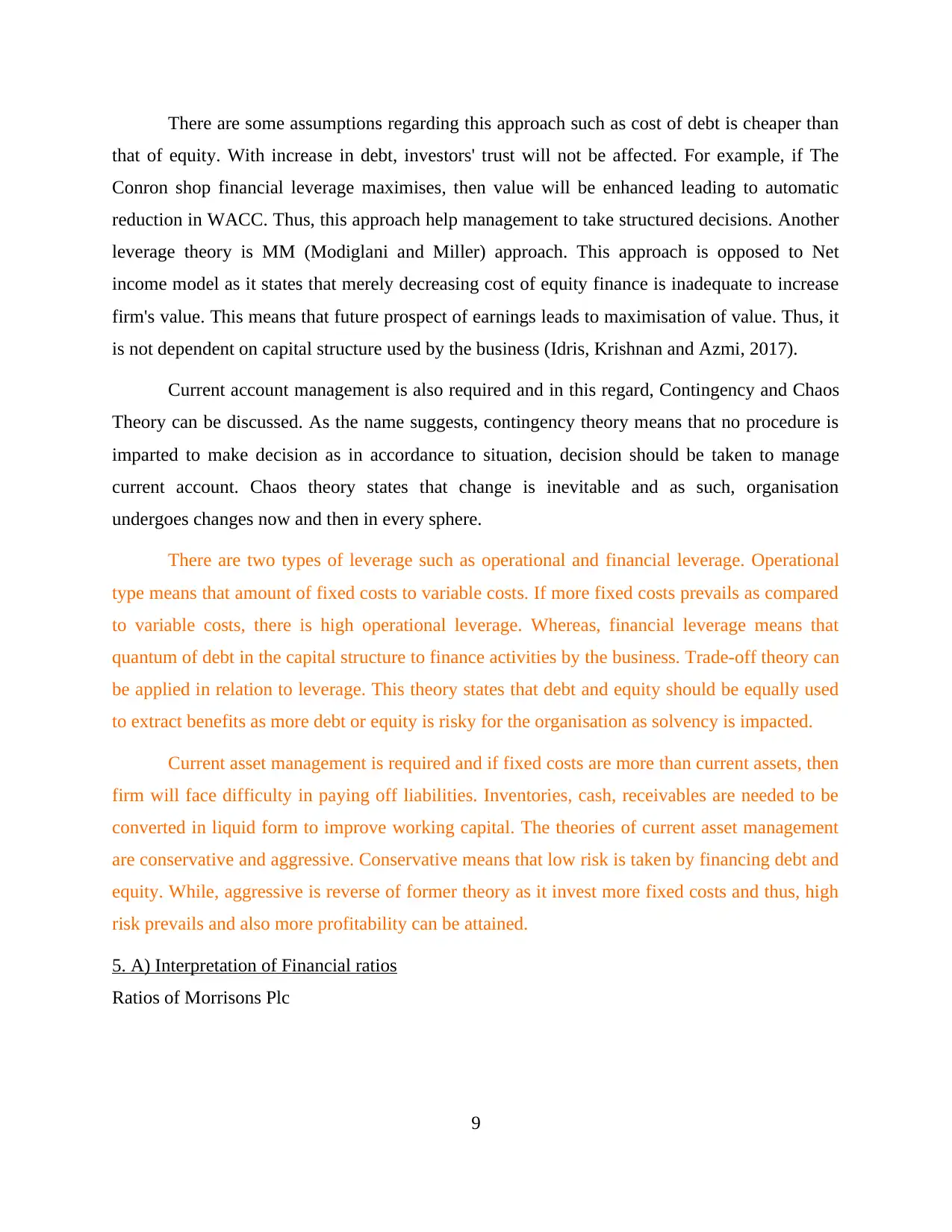
There are some assumptions regarding this approach such as cost of debt is cheaper than
that of equity. With increase in debt, investors' trust will not be affected. For example, if The
Conron shop financial leverage maximises, then value will be enhanced leading to automatic
reduction in WACC. Thus, this approach help management to take structured decisions. Another
leverage theory is MM (Modiglani and Miller) approach. This approach is opposed to Net
income model as it states that merely decreasing cost of equity finance is inadequate to increase
firm's value. This means that future prospect of earnings leads to maximisation of value. Thus, it
is not dependent on capital structure used by the business (Idris, Krishnan and Azmi, 2017).
Current account management is also required and in this regard, Contingency and Chaos
Theory can be discussed. As the name suggests, contingency theory means that no procedure is
imparted to make decision as in accordance to situation, decision should be taken to manage
current account. Chaos theory states that change is inevitable and as such, organisation
undergoes changes now and then in every sphere.
There are two types of leverage such as operational and financial leverage. Operational
type means that amount of fixed costs to variable costs. If more fixed costs prevails as compared
to variable costs, there is high operational leverage. Whereas, financial leverage means that
quantum of debt in the capital structure to finance activities by the business. Trade-off theory can
be applied in relation to leverage. This theory states that debt and equity should be equally used
to extract benefits as more debt or equity is risky for the organisation as solvency is impacted.
Current asset management is required and if fixed costs are more than current assets, then
firm will face difficulty in paying off liabilities. Inventories, cash, receivables are needed to be
converted in liquid form to improve working capital. The theories of current asset management
are conservative and aggressive. Conservative means that low risk is taken by financing debt and
equity. While, aggressive is reverse of former theory as it invest more fixed costs and thus, high
risk prevails and also more profitability can be attained.
5. A) Interpretation of Financial ratios
Ratios of Morrisons Plc
9
that of equity. With increase in debt, investors' trust will not be affected. For example, if The
Conron shop financial leverage maximises, then value will be enhanced leading to automatic
reduction in WACC. Thus, this approach help management to take structured decisions. Another
leverage theory is MM (Modiglani and Miller) approach. This approach is opposed to Net
income model as it states that merely decreasing cost of equity finance is inadequate to increase
firm's value. This means that future prospect of earnings leads to maximisation of value. Thus, it
is not dependent on capital structure used by the business (Idris, Krishnan and Azmi, 2017).
Current account management is also required and in this regard, Contingency and Chaos
Theory can be discussed. As the name suggests, contingency theory means that no procedure is
imparted to make decision as in accordance to situation, decision should be taken to manage
current account. Chaos theory states that change is inevitable and as such, organisation
undergoes changes now and then in every sphere.
There are two types of leverage such as operational and financial leverage. Operational
type means that amount of fixed costs to variable costs. If more fixed costs prevails as compared
to variable costs, there is high operational leverage. Whereas, financial leverage means that
quantum of debt in the capital structure to finance activities by the business. Trade-off theory can
be applied in relation to leverage. This theory states that debt and equity should be equally used
to extract benefits as more debt or equity is risky for the organisation as solvency is impacted.
Current asset management is required and if fixed costs are more than current assets, then
firm will face difficulty in paying off liabilities. Inventories, cash, receivables are needed to be
converted in liquid form to improve working capital. The theories of current asset management
are conservative and aggressive. Conservative means that low risk is taken by financing debt and
equity. While, aggressive is reverse of former theory as it invest more fixed costs and thus, high
risk prevails and also more profitability can be attained.
5. A) Interpretation of Financial ratios
Ratios of Morrisons Plc
9
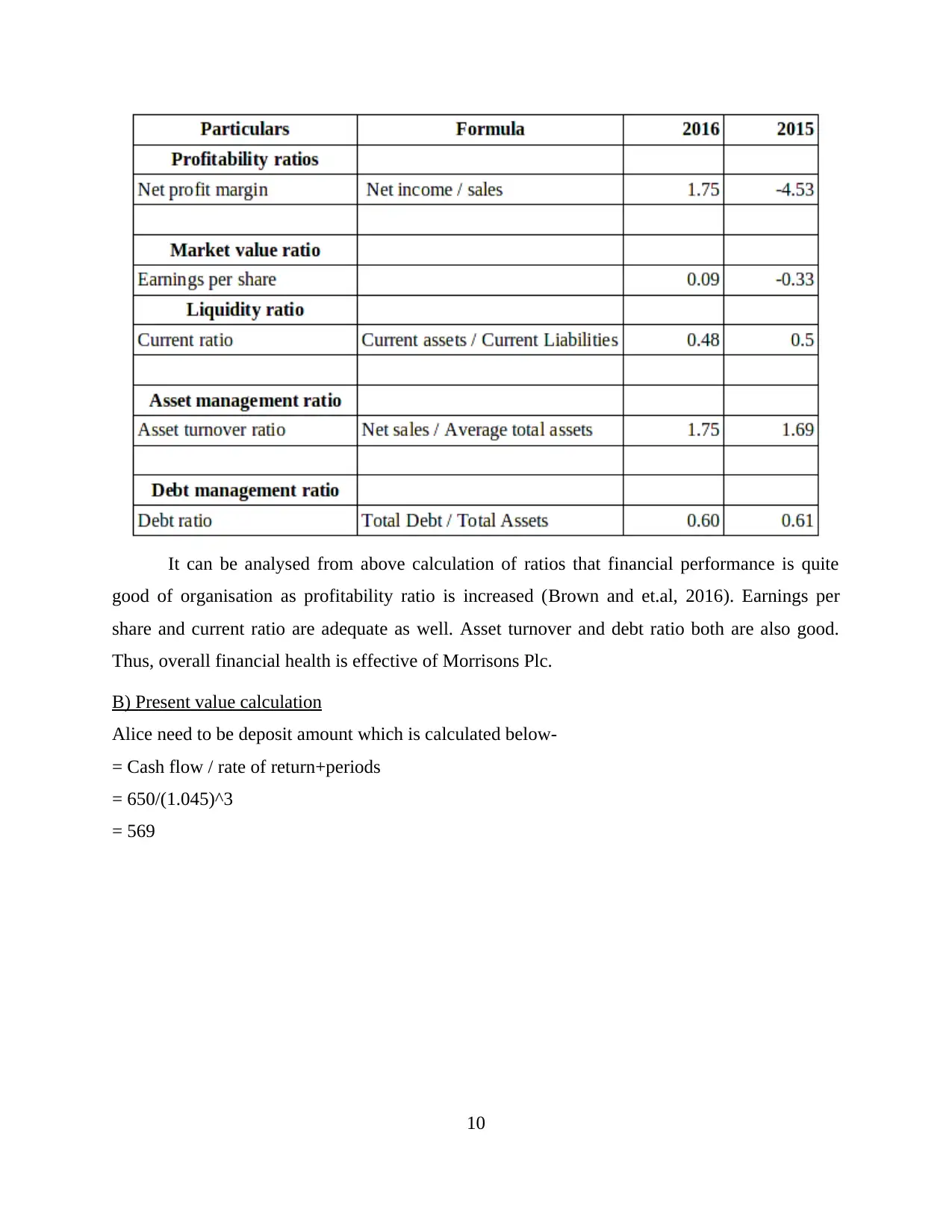
It can be analysed from above calculation of ratios that financial performance is quite
good of organisation as profitability ratio is increased (Brown and et.al, 2016). Earnings per
share and current ratio are adequate as well. Asset turnover and debt ratio both are also good.
Thus, overall financial health is effective of Morrisons Plc.
B) Present value calculation
Alice need to be deposit amount which is calculated below-
= Cash flow / rate of return+periods
= 650/(1.045)^3
= 569
10
good of organisation as profitability ratio is increased (Brown and et.al, 2016). Earnings per
share and current ratio are adequate as well. Asset turnover and debt ratio both are also good.
Thus, overall financial health is effective of Morrisons Plc.
B) Present value calculation
Alice need to be deposit amount which is calculated below-
= Cash flow / rate of return+periods
= 650/(1.045)^3
= 569
10
⊘ This is a preview!⊘
Do you want full access?
Subscribe today to unlock all pages.

Trusted by 1+ million students worldwide
1 out of 16
Related Documents
Your All-in-One AI-Powered Toolkit for Academic Success.
+13062052269
info@desklib.com
Available 24*7 on WhatsApp / Email
![[object Object]](/_next/static/media/star-bottom.7253800d.svg)
Unlock your academic potential
Copyright © 2020–2025 A2Z Services. All Rights Reserved. Developed and managed by ZUCOL.




